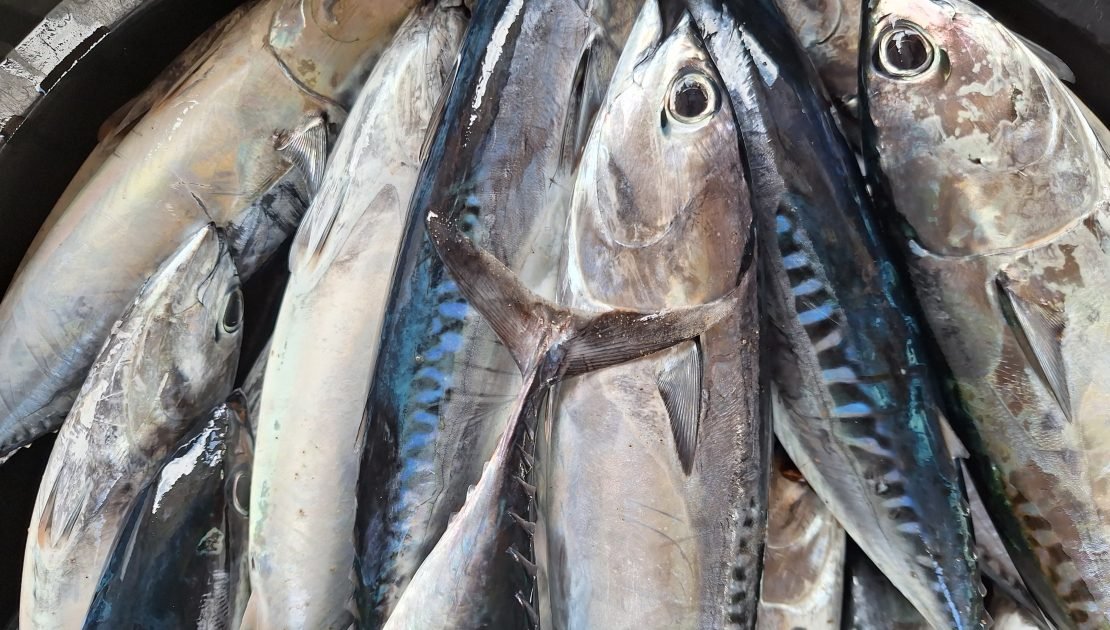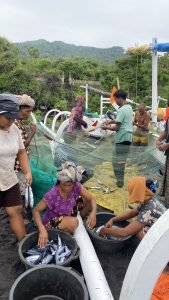
by Kai Garcia-Neefjes
After internal discussions, field assessments and consultations to explore new lines of work on species distinct from Tuna. In November of 2022, with the support of the Packard Family foundation, MDPI commenced work focused on neritic tuna species. The initial assessments led to the identification of two key sites situated in the volcanic Regency of Karangasem (east of Bali), where the coastline is characterized by a landscape of cliffs, boulder rocks, and dark sand beaches formed by ancient volcanic episodes.
When visiting its shores, its notable to observe great quantities of lined up white double outrigger vessels. These traditional fishing vessels, also known as ‘Jukungs’, are machine powered, generally equipped with 15 horsepower engines and colorful sails employed as an alternative to the engines when favorable wind conditions prevail.

The Jukungs measure around 5-6 meters in length and, while wooden exemplars are still used among fishers, nowadays, they opt for fiberglass construction instead, as this material has proven to be more durable and lighter for their operations. The fishing gear on board of the Jukungs can vary, including gillnets, handlines and longlines, and the average duration of a fishing trip on board of these vessels is a few hours.
In short, neritic tuna—also known as coastal tuna—are pelagic species that live closer to the continental shelf, around islands and archipelagos. Unlike albacore, skipjack, and yellowfin tuna, the behavior of neritic tuna doesn’t undertake transoceanic migrations, and they tend to surround tropical and sub-tropical waters1.
When we think about neritic tuna, it’s important to realize that we are not talking about just one species but rather a group of species. It is very common to hear people name and categorize different fish species as ‘neritic tuna’, or ‘tongkol’ in Indonesian language.

Despite this fact, when looking into the species portfolio managed by Indian Ocean Tuna Commission (IOTC)—one of the 17 existing Regional Fishery Management Organizations (RFMOs), aside of tunas and billfishes, six main neritic and tuna-like species are on the spotlight. These are: Longtail tuna (Thunnus tonggol), Frigate Tuna (Auxis thazard), Bullet tuna (Auxis rochei), Kawakawa (Euthynnus affinis), Narrow-Based Spanish mackerel (Scomberomorus commerson) and Indo-Pacific King mackerel (Scomberemorus guttatus).
Read also: What is a Regional Fishery Management Organization? The Pew Charitable Trusts
The IOTC has a dedicated ‘Working Party on Neritic Tunas’2 with experts from member countries that meet once a year to assess the status of the stocks, evaluate, and provide updates on other management measures. Following this, as a member of the IOTC, Indonesia through the Ministry of Fisheries and Marine Affairs (MMAF) manages these species nationally under the regulation KP. No. 121/2021 which refers to the National Management Plan of Tuna and Neritic Tuna (NTMP).

“Tongkol has always been a dish I have been eating ever since I was a little kid,” says our colleague, Agus. He is from Klungkung (a city nearby Karangasem) and works as a field implementer in MDPI.
During a phone conversation, he tells me, “The Karangasem Regency is a great producer of tongkol, and Balinese people are generally aware of this, especially bullet tuna”.
Tongkol, also called as ‘Awan’ in Balinese, forms part of the culture of Balinese people, as these species have been traditionally utilized in religious ceremonies to respect and honor the ocean. I immediately take the opportunity and ask him a few more questions.
“So, Agus, tell me about the main highlight of your daily job. Can you describe what you feel when working close to these coastal communities?”
Agus: “I find my job very satisfying. I feel that my role contributes directly to the fishers and their households. I am continuously learning alongside them about the fishery, the species, their local wisdom, and fishing methods.
Among other aspects, my work allows me to provide trainings and gather data aimed to inform management. So far, based on the data we collected this past year (2023), we observed that the highest production month for bullet tuna was in April, and the lowest in February.
This is information that both MDPI and I didn’t know before working in this area. This key information helps better understand the fishery and reality in the field. I also greatly enjoy building relationships and gaining the trust of fishing communities.”
And Agus, when it comes to challenges, how do those make you feel?
Agus: “Despite the positive experiences I encounter in the field, my struggles mainly arise when I observe fishers coming back from hauling their nets without catching barely any fish. This makes me feel sad and doubt whether I should further discuss with them or just leave them for the time being.”

The Balinese fishers we work with are noticing changes in terms of fishing grounds, having to move further away to catch fish, and observing decreases of fish sizes at the landing sites. These changes may be signs of alterations in the fish stocks.
“However, I believe that as an NGO we can support the communities by developing other lines of work such as identifying champions who are eager to learn more about sustainable fishing practices, exploring livelihood diversification initiatives, and better understand the value chain and the market of these species so that fishers can maximize their efforts,” Agus added.
As Agus mentioned during our call, a crucial element on why MDPI is paying more attention to neritic tuna is because its greatly consumed domestically, it only takes one visit to a local fish market in Indonesia to observe great quantities of neritic tuna up for sale.
Although Indonesians overall acknowledge that tongkol is part of their daily diets, the information and knowledge of scientists and managers on the status of these stocks remains unknown and thus presents a challenge. This is not solely the case for Indonesia but also for other members that are part of the IOTC.
Nevertheless, experts are raising the need to pay more attention to neritic tuna, and suggestions have been made to increase data collection programs, including catch, effort, and life cycle data, to come up with analysis and results that can provide more information.
Therefore, one of the efforts that MDPI will continue to carry out in the upcoming years in Karangasem include port sampling activities to understand how much neritic tuna is being landed in our working areas throughout the year, fleet characterization to better understand how the fleet operates, and the implementation of a frame survey guideline. The latter was developed alongside experts from Badan Riset dan Inovasi National (BRIN), MMAF, Yayasan Konservasi Nusantara (YKAN), and the Asosiasi Perikanan Pole & Line dan Handline Indonesia (AP2HI).
The objective of the frame survey is to guide like-minded organizations on the type of data required by experts for further analysis, better understanding and hopefully in the longer-term better management of neritic tuna.
References:
[1] Sadiyah, L (2023, April 06). Indonesia’s neritic tuna fisheries: The importance and issues [PowerPoint slides]. National Research and Innovation Agency (BRIN).
[2] IOTC-WPNT13-13 2023. Report of the 13th Session of the IOTC Working Party on Neritic Tunas. Seychelles, 3-7 July 2023. IOTC-2023-WPNT13-R[E]: 63 pp.
Buku ini disusun untuk mempermudah identifikasi spesies hewan ERS dan ETP yang
berinteraksi dengan nelayan selama aktivitas penangkapan tuna berlangsung. Semua
sumber ilustrasi gambar dan informasi pada buku ini telah dicantumkan pada daftar
referensi.
Kisah dari kampung nelayan kecil di 5 provinsi (NTB, Sulawesi Selatan, Sulawesi Utara, Maluku, Maluku Utara) diceritakan oleh masyarakat dampingan dan para pendamping MDPI. Mimpi besar untuk menjangkau lebih luas masyarakat pesisir dengan berupaya pada peningkatan kesejahteraan nelayan kecil melalui pengembangan kapasitas, membangun kemandirian, dan ketahanan ekonomi serta memperkuat institusi lokal demi mendukung perikanan berkelanjutan. Banyak pengalaman inspiratif, cerita sukses, kendala, kritikan, rasa bangga dan haru bercampur aduk dikisahkan dalam buku ini.
Penulis:
Gede Sughiarta, Nilam Ratna, Arroyan Suwarno, Alief Dharmawan,
Adjie Dharmasatya, Hairul Hadi, Muhammad Taeran, Muh. Alwi, Sahril,
Siti Zuleha, Sri Jalil, Hizran Sampalu, Karel Yerusa, Novita Ayu Wulandari,
M. Subhan Moerid.
Penyunting:
Gede Sughiarta, Arroyan Suwarno, Nilam Ratna, Alief Dharmawan
Desain/Layout:
Gede Sughiarta
Foto:
Yayasan MDPI, Gede Sughiarta
Illustrasi:
Panca Kumara